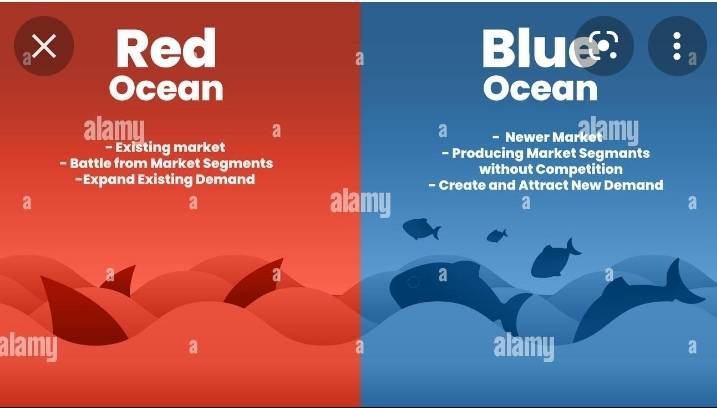The blue ocean strategy is considered one of the holy grails of marketing.
Most businesses often want to adopt this strategy while starting out. Honestly, who wouldn’t like to be part of a new, high-growth, uncontested market where the competitors are made to look irrelevant? It’s like selling candy to a kid without their parents around.
Pursuing a blue ocean strategy may sound like a great fit for your business, but it’s not always the case. It’s not always smooth sailing. If it were, every business would use it — which ruins the whole purpose behind the strategy.
Let’s begin with the definition of blue ocean and then explore the various red ocean challenges you need to avoid to be successful with the strategy.
What Is Blue Ocean Strategy?
In their famous book, Blue Ocean Strategy, Chan Kim and Renée Mauborgne coined the terms blue ocean and red ocean strategies. The general idea is that most often than not, businesses compete with each other in the same space, with similar products, chasing the same customers — which creates a bloody-red ocean in the customer acquisition process.
In contrast, the blue ocean is an analogy used to describe the unknown, unexplored marketplace that exists. Here, the demand is generated rather than fought over. The opportunity for growth is immense and improved profitability is expected if implemented correctly.
Examples
Apple found a blue ocean with its iTunes music download service back in 2003. Back when music files (in millions) were being downloaded illegally, they decided to create the first legal platform for downloading high-quality music for an extremely reasonable price.
Another great example of a blue ocean strategy is Cirque du Soleil. They carved out a new niche for them by adopting a theatrical/artistic approach to their performances as opposed to the general circuses you find. This led to them being an absolute hit with their target audience.
Ford Motor Company in the year 1908, had used a blue ocean strategy by introducing a car named Model T specifically to serve the masses. The car only came in one color but was durable, affordable, and reliable. They essentially created a new manufacturing process that produced cars at a fraction of what their competitors charge— so much that Model T officially replaced horse-drawn carriages as the main mode of transportation.
These examples are great success stories that demonstrate the power of a blue ocean strategy. It’s almost tempting to think that this is the right approach for every business. However, it would mean not fully understanding the different challenges you can face in pursuit of new oceans.
What are these challenges? Do you face them too? How can they be solved? Read on to learn about how they can be addressed.
Major Pitfalls (and How To Address Them)
There are certain assumptions we make while establishing a market-creation strategy. However, the trouble here is that these assumptions can often hamper our entry into the blue ocean and anchor us within the red ocean territory.
In an article listed on Harvard Business Review, Chan Kim & Renée Mauborgne beautifully illustrate the six possible traps businesses can fall into while seeking a blue ocean strategy. However, I believe three of them are extremely important to be aware of while adopting a blue ocean strategy.
Let’s dig into them a little deeper.
1. Keep existing customers happy and satisfied
In marketing, we are often trained toIn marketing, we are often trained to treat our customers as the royals of our business. There’s this staunch belief that keeping your existing customers happy can help you generate new demand. Although this may be true, it doesn’t necessarily grant you access to new markets.
To create new markets we must focus our attention on people who are not our customers (or non-customers). They can provide us with unbiased insight and help us focus on an entirely new set of pain points.
If we choose to focus on our existing customers, we only enhance our present offering to gain a leg up against our competitors — which also means staying within the limits of the red ocean.
A great example here is the battle between Sony and Amazon in the e-reading space. In the year 2006, Sony decided to launch a Portable Reader System (PRS), which was a thin, lightweight, easy-to-read device. The product was a result of a study they conducted to understand what problems do their existing customers face when it comes to e-reading.
However, during 2007, Amazon entered the market by offering their new product Kindle to compete with the PRS. Within a few hours from the date of the launch, the product sold out since they offered many more e-title options than PRS while making it easily downloadable online.
Want to know why they won?
They targetted the non-customers and listened to their needs. Their main reason for not using e-readers had nothing to do with the size, display, or functionality of the device, whereas, it was the shortage of worthwhile e-titles. Fast forward to today, and Kindle now offers over 6 million e-titles.
It’s not always about your existing customers. You may be losing out on the chance to access a whole new market by not listening to the non-customers of your business and their pain points.
2. Confusing technological innovations for new markets
Every time we hear about a cool, new innovation, we tend to assume that there’s a market for it. We live in a society where technological innovation is considered a key driver of market expansion. However, that’s not always the case.
You don’t always need technology to gain access to new markets. Let’s take Starbucks for example, they transitioned from selling you coffee to selling you a whole experience. Take a trip to your nearest Starbucks coffee shop to know what I’m talking about.
Besides, not every technological innovation can be successful in creating a new market. Let’s talk about Google Glass, when announced back in 2013, everyone believed that it would sell in the market like hot cupcakes. However, theatres, hospitals, classrooms, and other public places banned the device with regard to privacy concerns.
Want to know what went wrong?
Google Glass was most maybe one of the greatest tech innovations we’ve had in a while, but failed to deliver value to its customers. They focused on tech innovation over value innovation. Value innovation is all about making your customer’s life easy, productive, stylish, and less risky. They failed to deliver on this promise.
Value innovation can be a major factor to gain entry into new markets. Technological innovation can only bring you halfway there but in order to be successful, they must address the factors above.
3. Utilize low cost as a market creation strategy
As businesses, we believe that pricing our products at a low cost will always grant us access to new markets. It’s believed to be a game-changer. However, the focus is to get rid of features in the current offering to fit that price bill. We often tend to ignore what we can do to improve the value of the offering.


